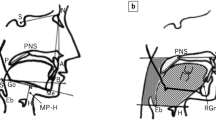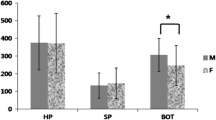Abstract
The aim of this investigation was to evaluate the contribution of cephalometry to a statistical model integrating clinical, physical, and oximetric variables, to reduce demands for polysomnographies. Two hundred and twenty-five consecutive patients that had been referred to the sleep clinic for suspected obstructive sleep apnea (OSA) were studied. The clinical assessment of all patients consisted of a sleep related questionnaire, the Epworth sleepiness scale, and a physical examination. In addition, they all underwent spirometry, cephalometry, and a full polysomnography. The clinical variables related with OSA were questions concerning witnessing of apneas by bed partners, intensity of snoring, a history of hypertension, and nocturia. A significant relation was also found with score on the Epworth scale, sex, age, body mass index, neck and waist circumferences, total number and frequency of oxygen desaturations, and the lowest oxygen saturation value. Significant cephalometric measurements were: the linear distance from gonion to gnathion, from the hyoid bone to the mandibular plane, and from the posterior nasal spine to the tip of the soft palate, and the thickness of the uvula as well. A statistical model was built to estimate a patient’s probability of having OSA based on clinical variables, physical examination, pulse oximetry, and cephalometry. The validation of this model demonstrated a remarkable ability in reducing the number of polysomnographic studies. We conclude that cephalometry combined with clinical variables, physical examination, and nocturnal oximetry is useful in the diagnosis of OSA and enables the sparing of a considerable number of polysomnographies.



Similar content being viewed by others
References
American Thoracic Society (1989) Indications and standards for cardiopulmonary sleep studies. Am Rev Respir Dis 39:559–568
Rowley JA, Aboussouan LS, Badr MS (2000) The use of clinical prediction formulas in the evaluation of obstructive sleep apnea. Sleep 23:929–937
Ross SD, Sheinhait MA, Harrison KJ, Kvasz M, Connelly JE, Shea SA, Allen IE (2000) Systematic review and meta-analysis of the literature regarding the diagnosis of sleep apnea. Sleep 23:1–14
Pracharktam N, Nelson S, Hans MG, Broadbent BH, Redline S, Rosenberg C, Strohl K (1996) Cephalometric assessment in obstructive sleep apnea. Am J Orthod Dentofac Orthop 109:410–419
Maltais F, Carrier G, Cormier Y, Seriès F (1991) Cephalometric measurements in snorers, non-snorers, and patients with sleep apnea. Thorax 46:419–423
Chiner E, Arriero JM, Signes-Costa J, Marco J, Fuentes I (1999) Validation of the Spanish version of the epworth sleepiness scale in patients with a sleep apnea syndrome. Arch Bronconeumol 35:422–427
Viner S, Szalai JP, Hoffstein V (1991) Are history and physical examination a good screening test for sleep apnea? Ann Intern Med 115:356–359
Hoffstein V, Szalai JP (1993) Predictive value of clinical features in diagnosing obstructive sleep apnea. Sleep 16:118–122
Flemons WW, Whitelaw WA, Brant R, Remmers JE (1994) Likelihood ratios for sleep apnea clinical prediction rule. Am J Respir Crit Care Med 150:1279–1285
Kump K, Whalen C, Tishler PV, Browner I, Ferette V, Strohl KP, Rosenberg C, Redline S (1994) Assessment of the validity and utility of a sleep-symptom questionnaire. Am J Respir Crit Care Med 150:735–741
Pouliot Z, Peters M, Neufeuld H, Kryger MH (1997) Using self-reported questionnaire data to prioritize OSA patients for polysomnography. Sleep 20:232–236
Fogel RB, Malhotra A, White DP (2004) Pathophysiology of obstructive sleep apnoea/hypopnoea. Thorax 59:159–163
Schellenberg JB, Maislin G, Schwab RJ (2000) Physical findings and the risk of obstructive sleep apnea. Am J Respir Crit Care Med 162:740–748
Hardling SM (2001) Prediction formulae for sleep-disordered breathing. Curr Opin Pulm Med 7:381–385
Tsai WH, Remmers JE, Brant R, Flemons WW, Davies J, Macarthur C (2003) A decision rule for diagnostic testing in obstructive sleep apnea. Am J Respir Crit Care Med 167:1427–1432
Netzer N, Eliasson AH, Netzer C, Kristo DA (2001) Overnight pulse oximetry for sleep-disordered breathing in adults. Chest 120:625–633
Ryan PJ, Hilton MF, Boldy DAR, Evans A, Bradbury S, Sapiano S, Prowse K, Cayton RM (1995) Validation of British Thoracic Society guidelines for the diagnosis of sleep apnoea/hypopnoea syndrome: can polysomnography be avoided? Thorax 50:972–975
Chiner E, Signes-Costa J, Arriero JM, Marco J, Fuentes I, Sergado A (1999) Nocturnal oximetry for the diagnosis of the sleep apnoea hypopnoea syndrome: a method to reduce the number of polysomnographies? Thorax 54:968–971
Deegan PC, McNicholas WT (1996) Predictive value of clinical features for the obstructive sleep apnea syndrome. Eur Respir J 9:117–124
Milles PG, Vig PS, Weyant RJ, Forrest TD, Rockette HE (1996) Craniofacial structure and obstructive sleep apnea syndrome—a qualitative analysis and meta-analysis of the literature. Am J Orthod Dentofac Orthop 109:162–172
Schwab RJ (1998) Upper airway imaging. Clin Chest Med 19:21–54
Bates CJ, McDonald JP (2005) The relationship between severity of obstructive sleep apnoea/hipopnoea syndrome (OSAHS) and lateral cephalometric radiograph values: a clinical diagnostic tool. Surgeon 3:338–346
Partinen M, Guilleminault C, Quera-Salva MA, Jamieson A (1988) Obstructive sleep apnea and cephalometric roentgenograms. Chest 93:1199–1205
Author information
Authors and Affiliations
Corresponding author
Rights and permissions
About this article
Cite this article
Julià-Serdà, G., Pérez-Peñate, G., Saavedra-Santana, P. et al. Usefulness of cephalometry in sparing polysomnography of patients with suspected obstructive sleep apnea. Sleep Breath 10, 181–187 (2006). https://doi.org/10.1007/s11325-006-0073-y
Published:
Issue Date:
DOI: https://doi.org/10.1007/s11325-006-0073-y




